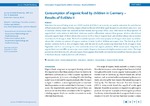Consumption of organic food by children in Germany –
Results of EsKiMo II
Haftenberger, Marjolein
Lehmann, Franziska
Lage Barbosa, Clarissa
Brettschneider, Anna-Kristin
Mensink, Gert B. M.
Data from the second Eating study as a KiGGS module (EsKiMo II, 2015–2017), are used to determine the contribution
of food produced by organic farming (organic food) to the diet of children aged between six and eleven years (n=1,190)
in Germany. Dietary intake was assessed by food records during a total of four days. Information on the proportion of
organic food intake relative to daily food intake was used to differentiate between three groups: children who did not
consume organic food; children whose diet contains 8.0% or less of organic food; and children whose diet comprises
more than 8.0% of organic food. The 8.0% threshold represents the mean proportion of organic food eaten by children
whose diet includes any amount of organic produce. In total, 63.2% of children eat organic food. The diet of 43.0% of
children contains 8.0% or less of organic food, with the diet of 20.2% comprising more than 8.0% of organic food.
Vegetables and fruit are among the most commonly consumed organic products. While consumption frequency of
organic food does not differ by sex or age, consumption frequency increases with higher socioeconomic status. The large
proportion of children (63.2%) who eat organic food suggests that health, environmental and ethical motives play a role
in the food choices made by families with children.
Dateien zu dieser Publikation
Keine Lizenzangabe

